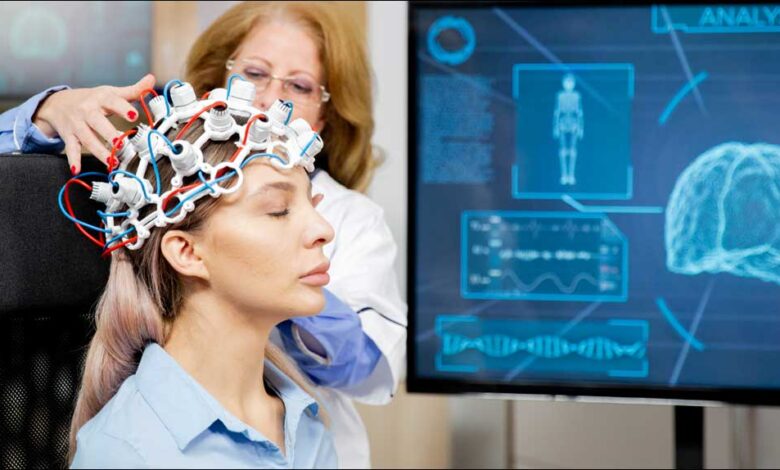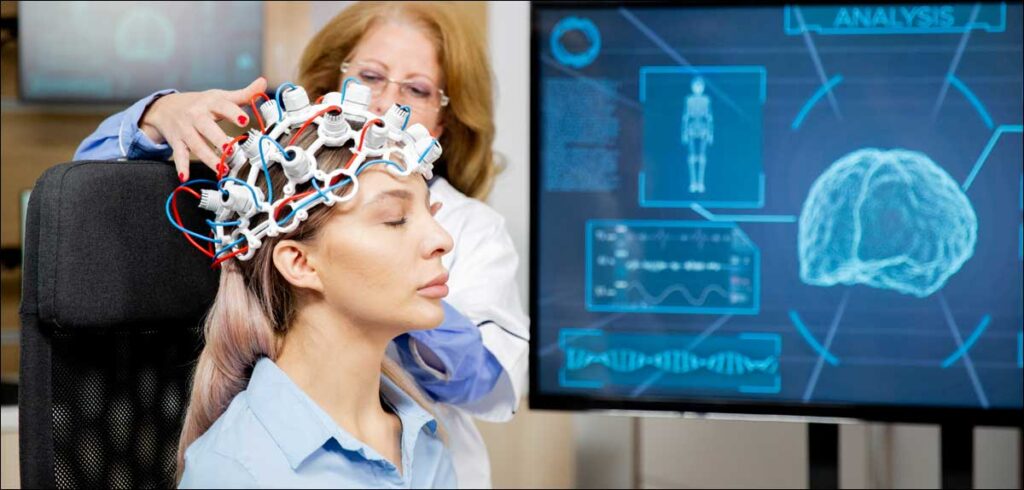Brain Computer Interfaces the Future of Interaction (BCIs)

Brain Computer Interfaces advancements in technology have paved the way for groundbreaking innovations, and one such revolutionary concept is the Brain-Computer Interface (BCI brain). BCIs hold immense potential to transform the way we interact with technology and have far-reaching implications across various fields.
In this article, we delve into the intricacies of BCIs, their applications, challenges, and the exciting future they hold. Join us on this journey as we unravel the fascinating world of Brain Computer Interfaces system.
Section 1: Understanding Brain Computer Interface Devices
What is a Brain-Computer Interface?
A Brain-Computer Interface (bci brain) is a system that establishes a direct brain computer interfaces for communication and control pathway between the brain and an external device, such as a brain and computer interface or a prosthetic limb. It enables individuals to control and interact with technology using their brain activity, bypassing the need for conventional motor-based inputs.
1.2 How Does a BCI Work?

BCIs operate through the acquisition, interpretation, and translation of brain signals into actionable commands. The process involves multiple stages, including signal acquisition through invasive or non-invasive methods, signal processing and analysis, feature extraction, and decoding into meaningful commands that can be executed by the external device.
1.3 Types of Brain Computer Interfaces system
Invasive BCIs: These interfaces involve the implantation of electrodes directly into the brain tissue to record neural activity with than high precision. They offer fine-grained control but require surgical procedures and carry associated risks.
- Non-Invasive BCIs: Non-invasive BCIs capture brain signals without the need for surgery. Common techniques include electroencephalography (EEG), functional near-infrared spectroscopy (fNIRS), and magnetoencephalography (MEG). While non-invasive BCIs are more accessible, they also typically provide lower resolution and require advanced signal processing techniques.
- Hybrid BCIs: Hybrid Brain Computer Interface devices combine multiple modalities, such as EEG and eye-tracking or EEG and electromyography (EMG), to enhance the accuracy and reliability of the interface. These systems leverage the strengths of different signal acquisition methods to achieve better performance.
- Fully Implanted BCIs: Fully implanted bci brain involve the implantation of electrodes or neural interfaces within the body, enabling direct brain computer interfaces system for communication and control between the brain and external devices. These interfaces hold promise for applications such as neuroprosthetics and deep brain stimulation.
Section 2: Applications of Brain Computer Interfaces:
2.1 Medical and Healthcare Applications
Neurorehabilitation: BCIs can facilitate motor rehabilitation for individuals with motor impairments by enabling them than to control prosthetic limbs or assistive devices through neural signals.
- Communication and Augmentative and Alternative Communication (AAC): BCIs offer a lifeline for individuals with severe motor disabilities by providing a means to communicate through neural commands, empowering them with a voice.
- Brain-controlled Prosthetics: BCIs enable individuals with limb loss or paralysis to regain functional control over artificial limbs, offering them than greater independence and improved quality of life.
- Brain-Machine Interfaces for Paralysis: Brain Computer Interfaces can help individuals with complete paralysis to interact with their environment, control robotic arms, or operate assistive technologies using their brain activity.
2.2 Augmented and Virtual Reality

- Enabling Hands-Free Interaction: Bcis brain can eliminate the need for controllers or gestures in AR/VR environments, allowing users to navigate and interact with virtual objects using their thoughts.
- Enhancing Immersion: BCIs can capture users’ cognitive and emotional states, allowing AR/VR systems to adapt and respond in real-time, resulting in personalized and highly immersive experiences.
- Gaming and Entertainment: Brain Computer Interfaces system hold the promise of creating novel gaming experiences by incorporating players’ brain activity as a control mechanism, providing a new level of interactivity and immersion.
2.3 Assistive Technology and Rehabilitation Brain Computer Interfaces
Enabling Environmental Control: BCIs can enable individuals with severe disabilities to control their surroundings, such as turning on lights, adjusting temperature, or opening doors, using their brain signals.
- Neurofeedback for Mental Health: BCIs can also be used in conjunction with neurofeedback techniques to provide real-time information about brain states, helping individuals improve focus, attention, and emotional regulation.
- Stroke Rehabilitation: Brain Computer Interface devices can also assist in stroke rehabilitation by promoting neuroplasticity and facilitating motor recovery through brain-controlled robotic devices and virtual reality-based therapy.
2.4 Gaming and Entertainment Brain Computer Interfaces
Brain-Controlled Gameplay: BCIs enable players to control characters or actions within games using their brain activity, creating immersive and interactive gaming experiences.
- Emotionally Adaptive Content: Bcis brain can also detect users’ emotional states and tailor game content, storylines, or virtual environments accordingly, creating personalized and emotionally engaging gameplay.
- Virtual Reality Enhancements: BCIs combined with virtual reality technologies can also provide enhanced sensory feedback. Allowing users to experience games with heightened realism and immersion.
2.5 Cognitive Enhancement and Neurofeedback
Attention and Focus Training: Brain Computer Interfaces system can also provide real-time feedback on users’ attention levels, helping them develop and sustain focus. Which can also be beneficial for tasks that require concentration and mental engagement.
- Brain Training and Mental Performance: BCIs can also be used as tools for brain training. Improving cognitive skills such as memory, attention. Problem-solving, leading to enhanced mental performance.
- Stress Reduction and Relaxation: BCIs can detect physiological markers of stress and trigger interventions such as relaxation exercises or calming visualizations, promoting stress reduction and emotional well-being.
Section 3: Challenges and Future Directions:
3.1 Ethical Considerations and Privacy
Informed Consent: The importance of obtaining informed consent from users than participating in bci brain research or using. Brain Computer Interfaces technologies to ensure transparency and respect for individual autonomy.
- Privacy Protection: Addressing concerns related to the storage and sharing of sensitive brain data. Ensuring robust data security than measures, and establishing clear guidelines for data usage and ownership.
- Cognitive Privacy: Examining the potential risks and ethical implications associated with accessing individuals’ thoughts, emotions, and cognitive states through BCIs.
3.2 Technological Challenges and Limitations
- Signal Quality and Reliability: Enhancing signal quality and reliability to ensure accurate. Consistent interpretation of brain signals for effective brain computer interfaces for communication and control.
- Signal Processing and Interpretation: Advancing signal processing algorithms and machine learning techniques to improve the speed. Accuracy of decoding brain signals into meaningful commands.
- User Training and Adaptation: Overcoming the learning curve and individual differences in user adaptation to Brain Computer Interface devices, ensuring ease of use and maximizing the potential for widespread adoption.
3.3 Advancements in Neurofeedback and Neural Implants Brain Computer Interfaces
- Closed-Loop Systems: Developing closed-loop bci brain systems that enable bidirectional communication between the brain and external devices. Allowing real-time adjustments based on neural feedback.
- Miniaturization and Biocompatibility: Progressing toward smaller, more also biocompatible implantable devices that minimize invasiveness. Enhance long-term viability, and reduce the risk of complications.
- Neural Plasticity and Adaptation: Exploring the potential of Brain Computer Interfaces to facilitate neuroplasticity. Neural adaptation, allowing the brain to learn and adapt to the interface more also effectively.
3.4 Integration with Internet of Things (IoT) and Artificial Intelligence (AI)
IoT Connectivity: Integrating BCIs with also IoT devices to enable a broader range of interactions. Such as controlling smart home devices, accessing online services, or interacting with virtual assistants.
- AI Algorithms and Cognitive Models: Leveraging AI algorithms and cognitive models to improve bci brain performance. Enhance the accuracy of brain signal decoding, and enable more sophisticated applications.
- Brain-Inspired Computing: Exploring brain-inspired computing architectures and neuromorphic systems that mimic the brain’s processing principles. Facilitating faster and more also efficient Brain Computer Interface system operations.
3.5 Promising Future Developments and Research Directions
Hybrid Interfaces: Advancing hybrid BCIs that combine multiple signal modalities, such as EEG and fNIRS or EEG and eye-tracking, to capture a richer set of brain activity and enhance overall system performance.
- Wireless and Non-Invasive Solutions: Developing wireless and non-invasive BCI technologies that eliminate the need for physical connections or invasive procedures. Making BCIs more accessible and user-friendly.
- Brain-to-Brain Communication: Exploring the potential of BCIs for direct brain-to-brain computer interface devices for communication and control. Enabling individuals to share thoughts, emotions, or sensory experiences with each other.
- Neural Interface Design: Innovating new materials and designs for neural interfaces that maximize biocompatibility, longevity. User comfort, paving the way for long-term and seamless integration with the human brain interface.
Section 4: Implications and Impact of Brain Computer Interfaces: Unlocking Boundless Possibilities
4.1 Empowering Individuals with Disabilities
- Regaining Independence: BCIs offer a means for individuals with paralysis or motor impairments to regain control over their environment, communicate, and perform daily tasks independently.
- Restoring Mobility: BCIs enable individuals with mobility limitations to control prosthetic limbs or exoskeletons. Allowing them to regain mobility and engage in activities previously deemed impossible.
- Improving Quality of Life: By providing access to communication, mobility, and interaction. Brain Computer Interfaces can significantly enhance the overall quality of life for individuals with disabilities, promoting inclusion and equal opportunities.
4.2 Enhancing Human-Computer Interaction
- Hands-Free Control: BCIs eliminate the need for physical inputs, such as keyboards or mice, enabling users to navigate, manipulate, and interact with digital interfaces using their thoughts.
- Seamless Integration: BCIs seamlessly integrate with existing technologies, allowing for natural and intuitive interaction. Opening up new possibilities for communication, creativity, and productivity.
- Personalized Experiences: BCIs can adapt to individuals’ cognitive states and preferences. Tailoring user interfaces and content delivery to optimize engagement and productivity.
4.3 Transforming Healthcare and Rehabilitation
- Neurofeedback Therapy: Brain Computer Interface system combined with neurofeedback techniques offer personalized training. Therapy for conditions such as attention deficit hyperactivity disorder (ADHD), anxiety, and post-traumatic stress disorder (PTSD).
- Stroke Rehabilitation: BCIs can facilitate stroke rehabilitation by promoting neural plasticity. Facilitating motor recovery through brain-controlled robotic devices and virtual reality-based therapy.
- Cognitive Assessment: bcis brain have the potential to provide objective and real-time cognitive assessments. Aiding in the diagnosis and treatment of cognitive disorders, such as Alzheimer’s disease and traumatic brain injuries.
4.4 Redefining Gaming and Entertainment Experiences
- Immersive Gameplay: BCIs enable players to control characters, objects, or actions within games using their brain activity, creating immersive and interactive gaming experiences.
- Emotional Engagement: BCIs can detect users’ emotional states and adapt game content, storylines, or virtual environments accordingly, enhancing emotional engagement and personalization.
- Virtual Reality Enhancement: Brain Computer Interfaces combined with virtual reality technologies provide enhanced sensory feedback. Enabling users to experience games with heightened realism and immersion.
4.5 Shaping the Future of Human Potential
- Amplifying Cognitive Abilities: BCIs can augment human brain interface cognitive abilities, such as memory, attention, and problem-solving, by leveraging neurofeedback and brain training techniques.
- Facilitating Brain-to-Brain Communication: Brain Computer Interfaces pave the way for direct brain-to-brain computer interface devices for communication and control, enabling the sharing of thoughts, emotions, or sensory experiences between individuals.
- Advancing Scientific Research: BCIs provide researchers with a window into the inner workings of the human brain interface. Facilitating neuroscience research and expanding our understanding of cognition and consciousness.
Conclusion Brain Computer Interfaces:
The realm of Brain Computer Interfaces holds immense promise, offering new avenues for brain computer interface system revolutionizing human computer interaction. From empowering individuals with disabilities to enhancing healthcare, gaming experiences. Beyond, BCIs have the potential to shape the future of human brain interface potential.
However, challenges such as ethics, privacy, and technological limitations need to be addressed as we forge ahead. As research and advancements in the brain continue to accelerate. We also stand on the precipice of a new era where the mind and technology seamlessly intertwine, opening doors to endless possibilities for human advancement.
You can also visit: Decentralized Finance (DeFi)







покупка франшизы покупка франшизы .
Hello! I could have sworn I’ve been to this site before but after going through some of
the articles I realized it’s new to me. Anyways,
I’m certainly pleased I came across it and I’ll be book-marking it and checking back often!